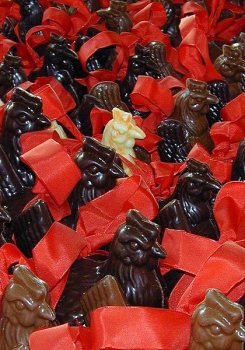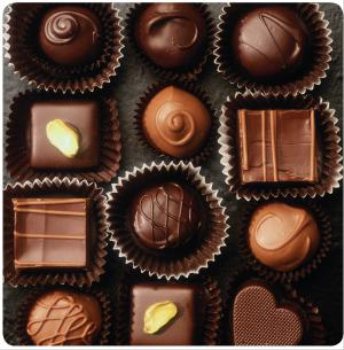|
We have watched it
grow, we eat it, so what is its history and how is it
made?
Chocolate is made up of a number of raw
processed foods that are produced from the seed of the cocoa tree. Cocoa has
been cultivated for at least three millennia in Central America and Mexico, with
its earliest documented use around 1100 BC. The majority of
the Mesoamerican peoples made chocolate beverages, including the Maya and
Aztecs, who made it into a beverage called xocolatl, a Nahuatl word meaning
"bitter water". The seeds of the cocoa tree have an intense bitter taste and
must be fermented to develop the flavour. To make 1 kilogram of chocolate it takes
300 to 600 beans. The
Netherlands is
the leading cocoa processing country, followed by the US.

Cocoa
bean output in 2005 - about 3,000,000 tonnes of cocoa is produced each year. The
global production was:
1,556,484
tonnes in 1974
1,810,611
tonnes in 1984
2,672,173
tonnes in 1994
3,607,052
tonnes in 2004 (record).
This
is an increase of 131.7% in 30 years, representing a cumulative average growth
rate (CAGR) of 2.8%.
The The
world's largest cocoa bean producing countries are as follows. The figure gives
the production estimates for the 2006–2007 season from the International Cocoa
Organization. The percentage is the proportion of the world's
total of 3.5 million tonnes for
the relevant period.
|
Country |
Amount
produced |
Percentage of world
production |
|
Cote
d'Ivoire |
1.3
million tonnes |
37.4% |
|
Ghana |
720
thousand tonnes |
20.7% |
|
Indonesia |
440
thousand tonnes |
12.7% |
|
Cameroon |
175
thousand tonnes |
5.0% |
|
Nigeria |
160
thousand tonnes |
4.6% |
|
Brazil |
155
thousand tonnes |
4.5% |
|
Ecuador |
118
thousand tonnes |
3.4% |
|
Dominican
Republic |
47 thousand tonnes |
1.4% |
|
Malaysia |
30 thousand tonnes |
0.9% |

Beginning:
After
fermentation, the beans are dried, cleaned, roasted, and the shell is
removed to produce cacao nibs. The nibs are then ground and liquefied, resulting
in pure chocolate in fluid form: chocolate liquour. The liquor can be further
processed into two components: cocoa solids and cocoa butter. Pure,
unsweetened chocolate contains primarily cocoa solids and cocoa butter in
varying proportions. Much of the chocolate consumed today is in the form of
sweet chocolate, combining chocolate with sugar. Milk
chocolate is sweet chocolate that additionally
contains milk powder or condensed milk. "White Chocolate" contains
cocoa butter, sugar, and milk but no cocoa solids (and thus does not qualify to
be considered true chocolate).
Chocolate contains
alkaloids such as theobromine and
phenethylamine, which have physiological effects on the
body. It has been linked to serotonin levels in the brain. Scientists
claim that chocolate, eaten in moderation, can lower blood pressure. Dark
chocolate has recently been promoted for its health
benefits, including a substantial amount of antioxidants that reduce the
formation of free radicals, though the presence of theobromine renders it toxic
to some animals, such as dogs and cats.
Chocolate has become one of the most
popular flavours in the world. Gifts of chocolate moulded into different shapes
have become traditional on certain holidays: chocolate bunnies and
eggs are popular
at Easter, chocolate coins on
Hanukkah, Santa Claus at Christmas
and hearts on
Valentine's Day. Chocolate is also used in cold and hot
beverages, to produce chocolate milk and hot chocolate.
  
History:
Chocolate has been used as a drink for
nearly all of its history. The earliest record of using chocolate dates back
before the Olmec. In November 2007 archaeologists reported
finding evidence of the oldest known cultivation and use of cacao at a site in
Puerto Escondido, Honduras, dating from about 1100 to 1400
BC. The residues found
and the kind of vessel they were found in indicate that the initial use of cacao
was not simply as a beverage, but the white pulp around the cacao beans was
likely used as a source of fermentable sugars for an alcoholic
drink. The Maya
civilization grew cacao trees in their backyard, and used the cacao seeds it produced to
make a frothy, bitter drink. Documents in Maya hieroglyphs stated that chocolate was used for
ceremonial purposes, in addition to everyday life. The chocolate residue found in an early
ancient Maya pot in Río Azul, Guatemala, suggests
that Maya were drinking chocolate around 400 AD. In the New World
xocoatl, and was
often flavoured with vanilla, chili pepper and achiote (known today as annatto). Xocoatl was
believed to fight fatigue, a belief that is probably attributable to the
theobromine content. Chocolate was also an important
luxury good throughout pre-Columbian Mesoamerica, and cacao beans were often
used as currency. For example, the Aztecs used a system in
which one turkey cost one hundred cacao beans and one fresh
avacado was worth
three beans. South
American and European cultures have used cocoa to treat diarrhoea for hundreds
of years. All of the areas that were conquered by the Aztecs that grew cacao
beans were ordered to pay them as a tax, or as the Aztecs called it, a
"tribute".
Until the 16th century, no European had
ever heard of the popular drink from the Central and South American peoples. It was not
until the Spanish conquest of the Aztecs that chocolate could be imported to
Europe, where it quickly became a court favourite. To keep up with the high
demand for this new drink, Spanish armies began enslaving Mesoamericans to
produce cacao. Even with cacao harvesting becoming a regular business, only
royalty and the well-connected could afford to drink this expensive import.
Before long, the Spanish began growing cacao beans on plantations, and using an
African workforce to help manage them. The situation was different in England.
Put simply, anyone with money could buy it. The first chocolate house opened in
London in 1657. In 1689, noted physician and collector Hans
Sloane developed a
milk chocolate drink in Jamaica which was initially used by
apothecaries, but later sold to the
Cadbury brothers.
For hundreds of years, the chocolate making
process remained unchanged. When the people saw the Industrial
Revolution arrive, many changes occurred that brought
about the food today in its modern form. A Dutch family's (van
Houten) inventions
made mass production of shiny, tasty chocolate bars and related products
possible. In the 1700’s, mechanical mills were created that squeezed out cocoa
butter, which in turn helped to create hard, durable chocolate. But, it was not
until the arrival of the Industrial Revolution that these mills were put to
bigger use. Not long after the revolution cooled down, companies began
advertising this new invention to sell many of the chocolate treats we see
today. When new machines were produced, people began experiencing and consuming
chocolate worldwide.

Types
White chocolate is formed from a mixture of
sugar, cocoa butter and milk solids. Although its texture is similar to milk and
dark chocolate, it does not contain any cocoa solids. Because of this, many
countries do not consider white chocolate as chocolate at all. Although first
introduced by Hebert Candies in 1955, Mars
Incorporated was the
first to produce white chocolate within the United States. Because it does not
contain any cocoa solids, white chocolate does not contain any theobromine, so
it can be consumed by animals.
Dark chocolate is produced by adding fat
and sugar to the cacao mixture. The US Government calls this "sweet chocolate", and requires
a 15% concentration of chocolate liquor. European rules specify a minimum of 35%
cocoa solids. Dark chocolate, with its high cocoa content, is a rich source of
the flavonoids epicatechin and gallic acid, which are thought to possess
cardioprotective properties. Dark chocolate has also been said to reduce the
possibility of a heart attack when consumed regularly in small amounts.
Semisweet chocolate is a dark chocolate with a low sugar content. Bittersweet
chocolate is chocolate liquor to which some sugar (typically a third), more
cocoa butter, vanilla and sometimes lecithin have been added. It has less sugar and
more liquor than semisweet chocolate, but the two are interchangeable in
baking.
Unsweetened chocolate is pure chocolate
liquor, also known
as bitter or baking chocolate. It is unadulterated chocolate: the pure, ground,
roasted chocolate beans impart a strong, deep chocolate
flavour.

|







